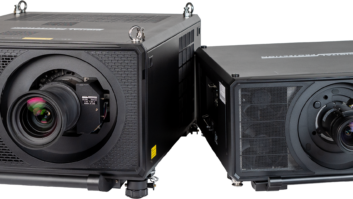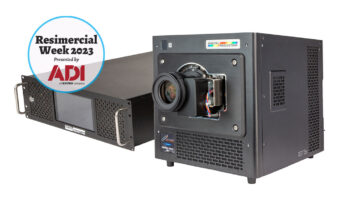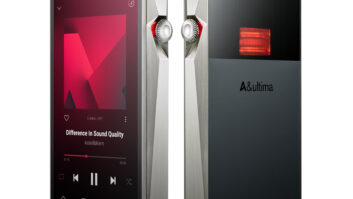I have figured out how to save you $40,000. That’s right, a full forty thousand big ones. Step right up, be the first of your neighbors to learn this one simple trick, and you too could have $40,000. But first, I’ll need 30 large. Let me explain…
Seven lenses are available for the HIGHlite Cine 260 HC, from a wide 0.77 fixed to a long-throw, 4.34-6.76:1

Panasonic sells a lot of $70,000 103-inch plasmas. Plus there’s shipping, reinforcing your walls, running a dedicated 240v line, and so on. But I get it, I really do. An image that huge, and most importantly, that bright is really compelling. So $70,000 and change. Or… you could get Digital Projection’s HIGHlite Cine 260 HC. See, I just saved you $40,000.
The reason is in the raw, unbridled power of this thing. On my 102-inch diagonal 1.0 gain Stewart StudioTek 100, I measured 31.4 foot-Lamberts. This is a staggering number. Most movie theaters are lucky to get nine foot- Lamberts off the screen. A decent home theater projector usually gets between 15-20 ft-L. Remember CRT projectors? Under 10.
Seven lenses are available for the HIGHlite Cine 260 HC, from a wide 0.77 fixed to a longthrow, 4.34-6.76:1 zoom. All lens controls are motorized and there’s significant vertical and horizontal lens shift available. If you want to add an anamorphic lens, there’s processing built in to stretch the image vertically. A remote is not included, though it’s unlikely that this projector won’t be hooked into a Crestron or Control4-type system.
There’s myriad setup options for the installer/calibrator, and it will need a calibrator. Out of the box the settings were ok, but color temperature in the most accurate setting (labeled 7500, actually) averaged about 600 Kelvin off the 6500 standard. After calibration, though, the HIGHlite Cine 260 HC measured near perfect, and tracked beautifully from 20 IRE to 100 IRE.
Color points were reasonably accurate in the SMPTE C mode, though they were still a little off, but close enough to appear accurate to the eye with regular video material. In Rec 709 mode, green was very greenish blue. Five different gamma mode options is good, though all seemed to crush blacks slightly, requiring a slightly higher brightness setting than test patterns indicated.
All the aforementioned light output comes at a cost. In Standard mode, the black level is 0.010 foot-Lamberts. Most modern projectors are capable of a lot darker. Economy mode improves this slightly to 0.009 while still putting out 26 ft-L on the other end. A bigger or negative gain screen (all measurements were on a neutral gain screen) would improve these numbers. Measured contrast ratio was around 3,000:1, which is more than enough for a punchy image, and better than most LCD flat panels.
Dynamic Black is an auto-iris type feature, off by default, which reduces light output during dark scenes (like a shot of space) and raises it during bright scenes (like a snow-covered mountain). I measured over 13,000:1 in this mode, the black level dropping to 0.002 ft-L. The problem is the contrast ratio in each shot within a scene is still limited by the DMDs (the 260 HC is a threechip DLP design). So Dynamic Black just makes the projector look dim on some scenes, and too bright on others. The amount of “pop” doesn’t change, regardless of the inflated dynamic contrast ratio numbers. I left this feature off and just basked in the light. One time, I held my arm in the light path and freckles instantly emerged. Just kidding. It took a minute.
Processing is very good across the board. The Cine 260 quickly picks up the 3:2 sequence with 480i and 1080i. With all jaggies tests, the size of jagged edges on diagonal lines was very small, though the amount was consistent across a wide range of angles. Some processors may have fewer jaggies across most angles, but then have large noticeable jagged edges on lines approaching horizontal. The Cine 260’s small jaggies are less noticeable even though they’re apparent more often. It’s a different approach, I guess, and I’d still say it’s better than a lot of processors.
Scaling detail, if you’re still using a DVD player, is above average as well. There’s a little more noise in the image with scaled material, but not much. A really good high-end Blu-ray player will likely outperform the Cine 260 in this regard, but not by much.
With Blu-ray and HD sources, the image is excellent, with very little noise. With the correct setup and calibration, it’s an accurate and punchy picture.
There are a few oddities. Despite a huge case the fan noise is louder than many other projectors. There’s also a fair amount of light leakage from the front. Given the price, it’s safe to assume this projector will be in a dedicated soffit or even a separate room. But also given that price, why the mediocre cabinet? Another indication this projector’s intended to be hidden is the industrial design, which could generously be described as “Bauhaus” but probably more accurately described as “Volvo.”
Past the objective tests, there’s the subjective. As I finish a review, I ask myself if a product is something I’d want to keep in my system. The HIGHlite Cine 260 HC’s brightness is so addictive, so pleasing to the eye, it’s going to be painful to go back to the comparatively dim and now sadly pedestrian projectors to which I’ve grown accustomed.
770.420.1350, www.digitalprojection.com
Kudos
It’s insanely bright and capable of a highly accurate image on an enormous screen.
Concerns
It is pricy. If you don’t especially need a huge screen, there are projectors offering a lot more for a lot less.
Product Specs
■ Seven lens options from a 0.77:1 fixed to a 4.34-6.76:1 zoom lens
■ 260-watt lamp
■ Three TI 0.65-inch DDR Darkchip DMDs
■ Motorized lens shift, zoom, and focus
■ Two HDMI 1.3, 2 component (1 RCA, 1 BN C), RGB-PC (D-Sub 15), S-Video and Composite
■ RS-232 and two 12v triggers







